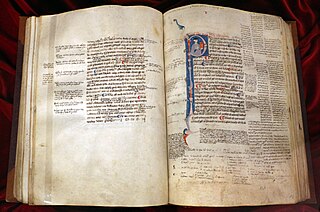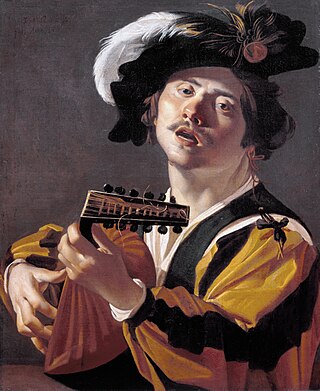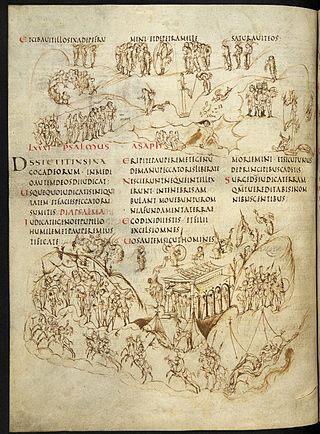Related Research Articles

The Physiologus is a didactic Christian text written or compiled in Greek by an unknown author, in Alexandria; its composition has been traditionally dated to the 2nd century AD by readers who saw parallels with writings of Clement of Alexandria, who is asserted to have known the text, though Alan Scott has made a case for a date at the end of the 3rd or in the 4th century. The Physiologus consists of descriptions of animals, birds, and fantastic creatures, sometimes stones and plants, provided with moral content. Each animal is described, and an anecdote follows, from which the moral and symbolic qualities of the animal are derived. Manuscripts are often, but not always, given illustrations, often lavish.

Christiaan Huygens, Lord of Zeelhem, was a Dutch mathematician, physicist, engineer, astronomer, and inventor who is regarded as a key figure in the Scientific Revolution. In physics, Huygens made seminal contributions to optics and mechanics, while as an astronomer he studied the rings of Saturn and discovered its largest moon, Titan. As an engineer and inventor, he improved the design of telescopes and invented the pendulum clock, the most accurate timekeeper for almost 300 years. A talented mathematician and physicist, his works contain the first idealization of a physical problem by a set of mathematical parameters, and the first mathematical and mechanistic explanation of an unobservable physical phenomenon.

William of Tyre was a medieval prelate and chronicler. As archbishop of Tyre, he is sometimes known as William II to distinguish him from his predecessor, William I, the Englishman, a former Prior of the Church of the Holy Sepulchre, who was Archbishop of Tyre from 1127 to 1135. He grew up in Jerusalem at the height of the Kingdom of Jerusalem, which had been established in 1099 after the First Crusade, and he spent twenty years studying the liberal arts and canon law in the universities of Europe.

In architecture, and specifically Gothic architecture, a gargoyle is a carved or formed grotesque with a spout designed to convey water from a roof and away from the side of a building, thereby preventing it from running down masonry walls and eroding the mortar between. Architects often used multiple gargoyles on a building to divide the flow of rainwater off the roof to minimize potential damage from rainstorms. A trough is cut in the back of the gargoyle and rainwater typically exits through the open mouth. Gargoyles are usually elongated fantastical animals because their length determines how far water is directed from the wall. When Gothic flying buttresses were used, aqueducts were sometimes cut into the buttress to divert water over the aisle walls.

The Gospel of Nicodemus, also known as the Acts of Pilate, is an apocryphal gospel claimed to have been derived from an original Hebrew work written by Nicodemus, who appears in the Gospel of John as an associate of Jesus. The title "Gospel of Nicodemus" is medieval in origin. The dates of its accreted sections are uncertain, but the work in its existing form is thought to date to around the 4th or 5th century AD.

The Prior Analytics is a work by Aristotle on reasoning, known as syllogistic, composed around 350 BCE. Being one of the six extant Aristotelian writings on logic and scientific method, it is part of what later Peripatetics called the Organon.

In Greek mythology, Clio, also spelled Kleio, is the muse of history, or in a few mythological accounts, the muse of lyre playing.
Martianus Minneus Felix Capella was a jurist, polymath and Latin prose writer of late antiquity, one of the earliest developers of the system of the seven liberal arts that structured early medieval education. He was a native of Madaura.

Dirck Jaspersz. van Baburen was a Dutch painter and one of the Utrecht Caravaggisti.

The Alexander Romance is an account of the life and exploits of Alexander the Great. Although constructed around a historical core, the romance is mostly fictional. It was widely copied and translated, accruing various legends and fantastical elements at different stages. The original version was composed in Ancient Greek some time before 338 CE, when a Latin translation was made, although the exact date is unknown. Several late manuscripts attribute the work to Alexander's court historian Callisthenes, but Callisthenes died before Alexander and therefore could not have written a full account of his life. The unknown author is still sometimes known as Pseudo-Callisthenes.

Anna Maria van Schurman was a Dutch painter, engraver, poet, classical scholar, philosopher, and feminist writer who is best known for her exceptional learning and her defence of female education. She was a highly educated woman, who excelled in art, music, and literature, and became a polyglot proficient in fourteen languages, including Latin, Ancient Greek, Biblical Hebrew, Arabic, Syriac, Aramaic, and Ethiopic, as well as various contemporary European languages. She was the first woman to unofficially study at a Dutch university.

Scanian law is the oldest Danish provincial law and one of the first Nordic provincial laws to be written down. It was used in the geographic region of Danish Skåneland, which at the time included Scania, Halland, Blekinge and the island of Bornholm. It was also used for a short period on the island of Zealand. According to some scholars, the Scanian Law was first set down between 1202 and 1216, around the same time it was translated into Latin by the Danish Archbishop Anders Sunesøn.

The Utrecht Psalter is a ninth-century illuminated psalter which is a key masterpiece of Carolingian art; it is probably the most valuable manuscript in the Netherlands. It is famous for its 166 lively pen illustrations, with one accompanying each psalm and the other texts in the manuscript. The precise purpose of these illustrations, and the extent of their dependence on earlier models, have been matters of art-historical controversy. The psalter spent the period between about 1000 to 1640 in England, where it had a profound influence on Anglo-Saxon art, giving rise to what is known as the "Utrecht style". It was copied at least three times in the Middle Ages. A complete facsimile edition of the psalter was made in 1875, and another in 1984 (Graz).

Abu Ishaq Ibrahim ibn Muhammad al-Farisi al-Istakhri was a 10th-century travel-author and geographer who wrote valuable accounts in Arabic of the many Muslim territories he visited during the Abbasid era of the Islamic Golden Age. There is no consensus regarding his origin. Some sources describe him as Persian, while others state he was Arab. The Encyclopedia Iranica states: "Biographical data are very meager. From his nesbas he appears to have been a native of Eṣṭaḵr in Fārs, but it is not known whether he was Persian".
The Eclogue of Theodulus was a Latin verse dialogue, which became a standard school text of the Middle Ages. Scholarship generally dates it to the 10th century, though earlier dates are also given.

Conrad of Hirsau or Hirschau was a German Benedictine monk and writer of the Hirsau Abbey. He is known for his literary work Dialogus super auctores, an accessus ad auctores written about 1130.
The Auctores octo morales was a collection of Latin textbooks, of an elementary standard, that was used for pedagogy in the Middle Ages in Europe. It was printed in many editions, from the end of the fifteenth century. At that time it became standardised as:
- Distichs of Cato
- Eclogue of Theodulus
- Facetus: Liber Faceti docens mores iuvenum
- De contemptu mundi
- Liber Floretus
- Matthew of Vendôme, Tobias
- Alan of Lille, Doctrinale altum parabolarum
- Aesop, version attributed to Gualterus Anglicus.
The Annals of St Neots is a Latin chronicle compiled and written at Bury St Edmunds in the English county of Suffolk between c. 1120 and c. 1140. It covers the history of Britain, extending from its invasion by Julius Caesar to the making of Normandy in 914. Like the Anglo-Saxon Chronicle, it is chiefly concerned with Anglo-Saxon history, but it differs from it in adopting a distinct East Anglian perspective on certain events and weaving a significant amount of Frankish history into its narrative.

The Institutes is a component of the Corpus Juris Civilis, the 6th-century codification of Roman law ordered by the Byzantine emperor Justinian I. It is largely based upon the Institutes of Gaius, a Roman jurist of the second century A.D. The other parts of the Corpus Juris Civilis are the Digest, the Codex Justinianus, and the Novellae Constitutiones.

Horologium Oscillatorium: Sive de Motu Pendulorum ad Horologia Aptato Demonstrationes Geometricae is a book published by Dutch mathematician and physicist Christiaan Huygens in 1673 and his major work on pendulums and horology. It is regarded as one of the three most important works on mechanics in the 17th century, the other two being Galileo’s Discourses and Mathematical Demonstrations Relating to Two New Sciences (1638) and Newton’s Philosophiæ Naturalis Principia Mathematica (1687).
References
- R. B. C. Huygens, ed. (1970) Accessus ad Auctores. Bernard d'Utrecht. Conrad D'Hirsau, Dialogus Super Auctores
- R. B. C. Huygens (1977), Bernard d'Utrecht, Commentum in Theodolum (1076–1099)